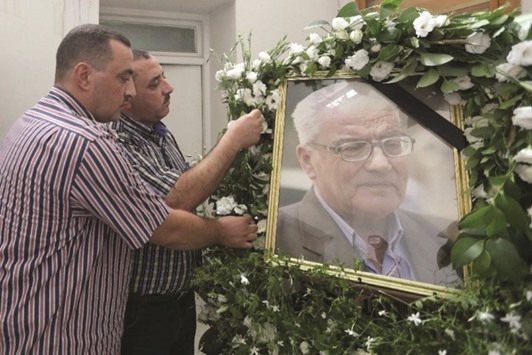The son of a Syrian archaeologist who was beheaded by Islamic State group militants in ancient Palmyra is on a mission to give his father a “dignified” burial near the world heritage site.
Khaled al-Assaad, known as “the father of Palmyra”, was 82 years old when IS fighters executed him on August 18, 2015, three months after the group overran the city known as the “Pearl of the desert”.
Syrian troops backed by Russian forces recaptured Palmyra on Sunday, after a fierce offensive to rescue the city from militants who view the Unesco-listed site’s magnificent ruins as idolatrous.
“The militants beheaded him and they placed his head on the ground, underneath his body, which hung from an electric pole in the main square of Palmyra,” 35-year-old Tareq Khaled al-Assaad told AFP at a museum in Damascus.
“Someone took his head and buried it, while two men rescued the body and buried it somewhere else. Our goal is to bring the head and the body back together and to lay him to rest in a dignified place in Palmyra,” Tareq said.
“We feel that my father’s joyful soul is soaring over Palmyra, hailing its liberation,” he said, adding that he plans to travel to the world heritage site “soon”.
“My niece, who is 10 years old, dreamt that her grandfather was sitting in the garden, smiling.”
Seen as one of the pioneers of Syrian archaeology, Assaad was director of antiquities in Palmyra for 40 years until 2003. He was responsible for the discovery of several ancient cemeteries at the site and oversaw the excavation of 1,000 columns as well as its stunning necropolis of 500 tombs. It was Assaad, too, who secured the listing of Palmyra as a World Heritage site.
When militants were closing in on the city in May 2015, Assaad’s sons managed with the help of security guards to rescue 400 ancient busts and other archaeological gems.
On May 20, the last van left Palmyra museum, just 10 minutes before IS arrived.
Assaad’s other son Walid, who took over from his father as the city’s new director of antiquities, was tortured by IS. To this day, he uses crutches to walk.
The militants “were looking for two tonnes of gold, but my brother told him there wasn’t any. To make him talk, they disfigured some statues in the museum, including the (Arabian) deity Al-Lat’s,” Tareq said. “My brother just kept telling them: ‘That’s the gold that you’re looking for.’”
After Palmyra fell, Assaad moved to Qasr al-Hayr al-Sharqi, 110km to the northwest.
On July 20, masked men entered the village demanding to know where he was “to give him an Islamic re-education” then sentenced the famed archaeologist to death.
His son believes he was executed because he refused to obey orders to pledge allegiance to IS.
Assaad asked to visit the museum one last time. His captors then led him with his hands tied and his feet bare to the heart of the city.
His killers scrawled their accusations on a placard pinned to the archaeologist’s body: being a regime loyalist, representing Syria at conferences abroad “alongside infidels”, and serving as the “director of idolatry” in Palmyra.
“He refused to kneel for his beheading. He told them that he wanted to remain as upright as the city’s columns and palm trees,” Tareq said.
He says his father’s decapitated body was left hanging in the city centre for three days, before IS fighters took it down and dumped it in a landfill outside the city.
“Two of my father’s friends watched the van drive away, and they then took my father’s body to give it a proper burial,” he said as he wept.
Tareq wants to bring closure to his family by putting his father to rest in a dignified burial, but he remains wracked with remorse.
“I feel guilty. I imagine my father in prison, wondering why the children he raised abandoned him. If I had known they were going to execute him, I would have gone there myself, and blown myself up to save him.”

The sons of Khaled al-Assaad, former chief archaeologist of Palmyra who was beheaded by the Islamic State group, pay tribute in this August 2015 file photo.
